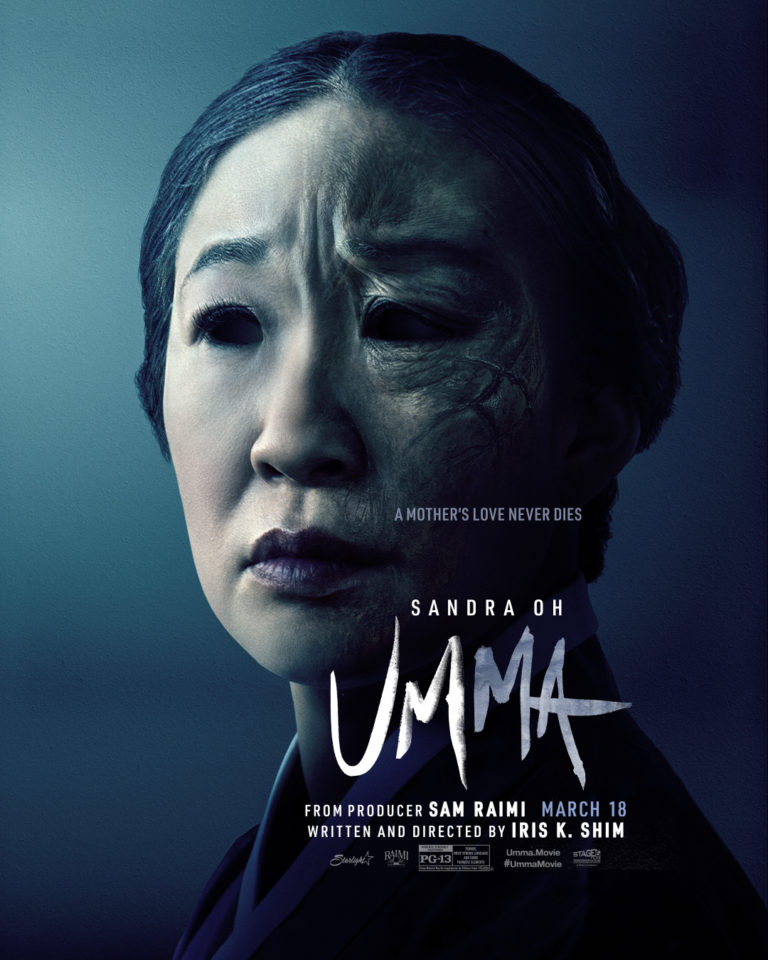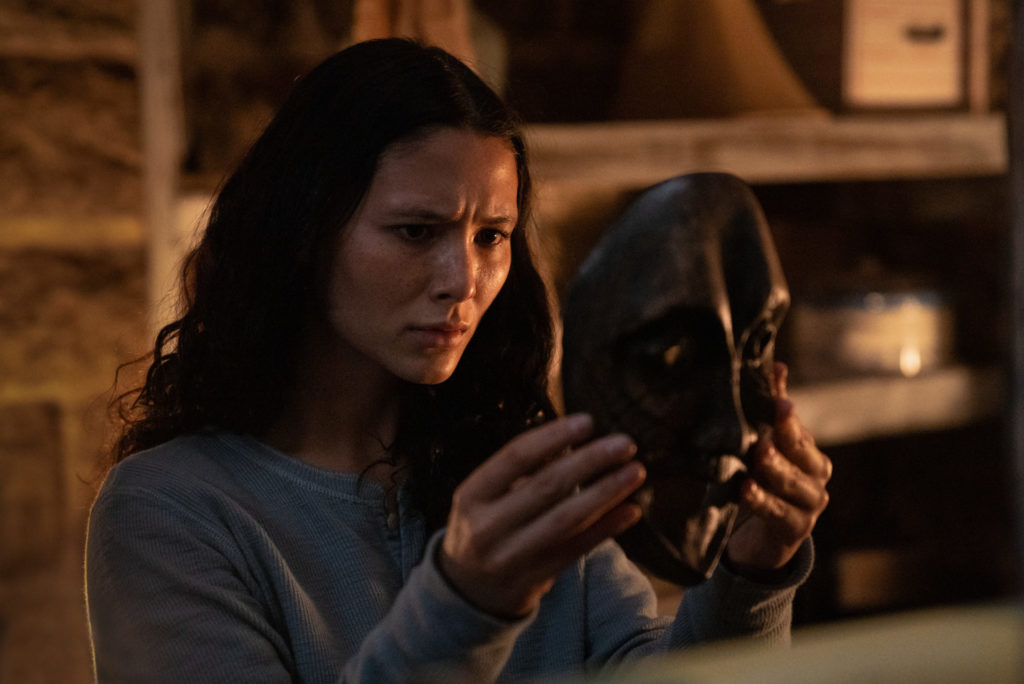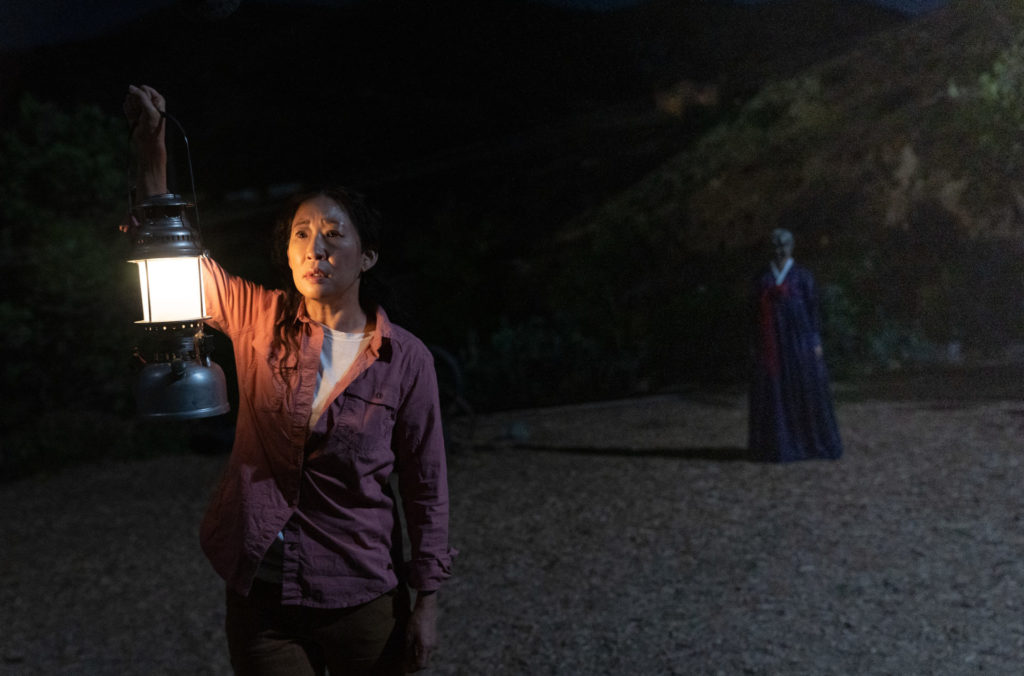
Synopsis : Umma, which is the Korean word for “mother,” follows Amanda (Sandra Oh) and her daughter (Fivel Stewart) living a quiet life on an American farm, but when the remains of her estranged mother arrive from Korea, Amanda becomes haunted by the fear of turning into her own mother.
An Exclusive Interview With Director Iris K. Shim
Q: I heard that you made a documentary ‘The House of Suh’ that got quite a lot of recognition from the festival circuit. How did that transition into writing a horror story which ended up being produced by Sam Raimi? That seems like quite a transition.
IKS: Yeah, definitely. I made the documentary that was my first movie, and I had never really intended to do a documentary. It’s just the story I that I happened to know. I felt the best way to tell it was a documentary. So yes, everything about the two projects is very different in the sense that, with the documentary, I made it with three or four people. It was very small, very low-budget, very scrappy.
This one was in a horror space, with a narrative – the machinery is so different. But I think the two common factors between those projects is that I was exploring family dynamics in immigrant households for both of them. So I wasn’t very conscious about having this movie dealing with family dynamics, but clearly it’s something that I’m very drawn to.
Q: Immigrant stories have been told in the past. How did you make this story so unique on your own? Because you also wrote the script for this one.
IKS: What I can say is that I really just tried to focus on drawing from my own experiences. Not to say that these are literally my experiences, I actually grew up in big cities, I didn’t grow up in isolated rural environments. And my relationship with my mom is very good, so it’s very different from the relationship in the movie.
Yeah, I think just tapping into the identity elements of it: exploring how these characters either connect or disconnect with some of the cultural elements and their heritage, and for them to reject it at first but then embrace it by the end. It was very much reflective of my own experience with that.
When I was growing up, I think my Korean identity was something that I didn’t necessarily reject, but it was something that I wasn’t exploring that much. When I was younger, I just wanted to fit in and I didn’t really want to feel different, so I didn’t want to remind anyone that I was Korean.
Now being older, it was something that I really wanted to embrace, so that was something that I brought into the story.
Q: This film pretty much relies on Sandra Oh’s performance. What conversations did the two of you have prior to shooting the film? Because there are a lot of scenes that require emotional roller coasters and things like that. Could you talk about working with Sandra?
IKS: Oh yeah, we spent a lot of time in the development stage talking about the character, talking about our experiences, and working on the scene work. Part of the work that she did was actually forming a relationship with the other actress, Fivel Stewart, so that they could be so comfortable with each other, they could genuinely portray this close mother-daughter relationship.
I have to give her a lot of credit in terms of the work she put in to form that relationship outside of the movie. I think this is a very challenging role for her, because she is both the protagonist and the antagonist. So for her to have to go back and calibrate that journey along the way was a really fun challenge.

Q: Speaking of Fivel, could you talk about the casting process of Fivel, because she is phenomenal as Sandra Oh’s character.
IKS: She’s so good. Yeah, it was hard, being the younger age, to get an actress that not only was just a good actor, but someone that felt like she could have been raised in this environment, to really feel like a real person. And I think Fivel also has a very unique upbringing.
So there was a lot that she brought herself into the role that just naturally came out in the audition. And our amazing casting director, Nancy Nayor, did a lot of work, did a lot of outreach, and we were also looking for non-actors as well. But Fivel was clearly the best one for the role.
Q: Even though you did this really amazing job with this film, you [didn’t do a] studio film like this one. So how did you collaborate with Sam Raimi for this one? Did he talk about a process of making it in some order?
IKS: Yeah. Sam Raimi is such an icon of horror, but it was very important for him. He recognized immediately that it was also so much about the relationship between the characters and that it wasn’t just horror for the sake of horror and scaring the audience.
We needed to preserve this character arc and this resolution between the characters. So that process was really great, just in terms of talking about “what can we do with the scares?” but that also services the story without compromising some of the relationship work that we had to do. So yeah, it was great.

Q: How do you see Sandra this entertainment industry? Is she like a role model? How do you see her in the Asian community in the entertainment industry?
IKS: Yeah, she’s definitely a role model. Even her just being on screen is so impactful. When I was growing up, there really wasn’t anyone that looked like me that was on the screen. And not only that, but having their own sort of dynamic characters, and they weren’t just supporting side characters.
So just her very presence, I think, really does so much and gives a lot of inspiration to younger people. But she’s also very curious, she’s very thoughtful, she really gives such a great energy in the way that she carries herself, just in general. I think it’s very inspiring for people that look up to her.
Q: There are some sequences that heavily rely on the post-production. So how did you mount those supernatural element sequences that you had [in this film]?
IKS: It was an interesting process where there were certain sequences that we thought we were going to use more VFX, and then it ended up being a little more grounded. Which to me, personally, I find a little bit scarier, when the film feels like it’s actually happening in real life. And then there were other sequences that we discovered later that we wanted to supplement a little bit more with VFX. So it was really a fun discovery process along the way.
Q: How do you want the audience to take away from this film? Because you rely on the history and the immigrant [experience] and mother-daughter relationships. Could you talk about that?
IKS: Personally, I think I would love for audiences to really recognize the mother-daughter relationships, because I do think that’s so universal. And even though the characters come from an immigrant background and there are these cultural elements to it, that’s not really what the story is about. They just happen to have this specific way into the story with these specific characters. But what they’re grappling with is something that is very, very universal in terms of complicated relationships with our mothers.
Q: Thank you.

